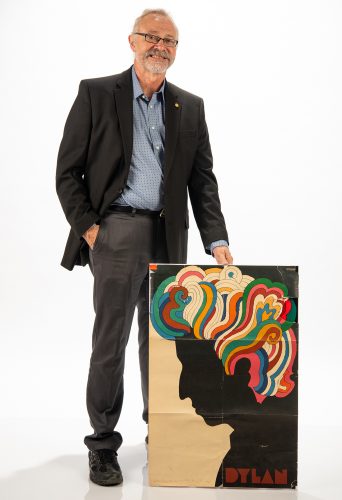Lewis Glaser and the Art of Good Design
In a Q&A, the chair of the new Department of Design discusses what makes a good graphic designer and the success of Connext.
Lewis Glaser and the Art of Good Design
In a Q&A, the chair of the new Department of Design discusses what makes a good graphic designer and the success of Connext.
Lewis Glaser, professor of graphic design and inaugural chair of the new Department of Design, reflects on his journey in the graphic arts and looks toward the future of integrated design.
What initially sparked your interest in graphic design?

Lewis Glaser is the chair of the new Department of Design. This Milton Glaser poster inspired his interest in graphic design. Photo by Glen E. Ellman
In middle school I bought Bob Dylan’s Greatest Hits Vol. II. Inside there was a poster that was pretty cool, so I hung it up on a wall in my room. The signature at the bottom of the poster was Milton Glaser, and I thought, “Wow, somebody with the same name as me is famous for something.” I figured if they were designing a poster, they must be famous. So it kind of got me interested in graphic design. I tucked that interest away until I took a summer class the first year I was in college. I was hooked.
Graphic design is often done in service of a client, who has specifications about how the product should look. How does a graphic designer express creativity?
The creative part is problem-solving, and it involves empathy — the heart and soul of graphic design. In order to create an effective design, the designer has to understand the client’s message, the market the message is targeting and the kinds of means of presenting information, which can include language as well as manipulating visual space or visual language to pique the interest of the person in that market. In my classes, I call it setting the hook and reeling them in. First, it’s visual: You get someone to turn from a casual observer to a reader. But the whole point is to elicit a specific response.
Graphic design is a competitive field. How do designers become successful?
You need to have some talent. You have to be a good thinker. You have to have an open mind and be willing to research to understand other people or groups of people’s attitudes and points of view. You have to be flexible enough to understand that maybe you really want to do it this way because you saw something on a design website, but it’s not going to work. You have to solve the problem, because if you don’t, then your design is not successful. A willingness to learn and understand about someone else’s perception is really the key to being successful in design so that you can inform, persuade or instruct.
A successful designer is also an intelligent generalist and an inquisitive person who is able to understand. This person knows a lot about a lot of things and is able to listen to someone who knows more about the problem than they do. This designer can pick up on the important points and distill them into a solution to another person’s problem.
“A successful designer is also an intelligent generalist and an inquisitive person who is able to understand.”
Lewis Glaser
In 2019, the College of Fine Arts integrated graphic design and interior design programs into the overarching Department of Design. What was the reason for reorganizing?
Interior design and fashion merchandising were once a department in AddRan College. They were kind of out of place with the more traditional liberal arts, so they moved into the College of Fine Arts in 2008. Well, then we had a design program for graphic design and a design program for interior design. We’re a lot more alike than we are different, so it became a matter of reorganizing things in a way that made sense academically and instructionally.
What would you like to see as a result of the integration of the different areas of design?
I would like to see our BS in design studies become a multidisciplinary degree that would involve a core foundation of classes — some graphic design, interior design, lighting design and architectural lighting design. It should allow options. If a student wants to push more toward one of those academic areas, great; if they want to mix them up, great. As long as they get the right combination of upper-division credit hours. We’re also talking about a certificate or minor in one of those areas, so someone could incorporate another field of study or focus on an entrepreneurial trajectory.
The Department of Design offers three majors: bachelor of fine arts in graphic design, bachelor of science in design studies and bachelor of science in interior design. What is the difference between the BFA and the BS?
The BFA is a professional program. Students need to complete 78 credit hours in the major. They go in-depth on various topical courses like advertising, design packaging, corporate identity and branding, and interactive design, which starts with web design but then gets more advanced to include some video editing and animation. By the time a student has completed the degree program, they’ve got a pretty solid background and a pretty solid portfolio.
The BS program requires 42 credit hours in the major, but it’s not a professional program like the BFA. It’s a liberal arts degree. It’s really intended to be combined with another strong interest. Our goal is to prepare the student with a good, solid foundation in applied design principles, not necessarily to make them graphic designers.
We are in discussion about creating a common foundation for all of the classes in graphic design, interior design and architectural lighting design because they’re all based on design principles. We want to structure our core curriculum in a way that supports all of those design specialties. I think it’ll be a great benefit for everyone and for our students, especially, so they all have the same consistent foundation.
The new Fine Arts Building, a 33,000-square-foot facility behind the J.M. Moudy Visual Arts and Communication Building, opened in fall 2019 to serve as a hub for the Department of Design. How has this new space affected learning opportunities?
It gave us more room to teach and a better organization of facilities. The specialized printing equipment, for example, was crowding classrooms, and that was a distraction.
“You have to have an open mind and be willing to research to understand other people or groups of people’s attitudes and points of view.”
Lewis Glaser
Each year the graphic design department holds Connext, an on-campus event where graphic design students are matched up to interview with prospective employers in the region for internships and permanent employment. How has this affected the employment rate for graduates of the program?
Connext is primarily focused on internships between students’ junior and senior years. However, we do have businesses come who are looking for permanent employees. All of our seniors attend as well, even if it’s just for the interview experience. In terms of placement of our graduating BFA students, we’ve been at 100 percent for almost eight years. It has really helped with placing students in summer internships. I’ve never not been able to place anybody in the time that I have been doing this, which is about 30 years.
We give every business that attends Connext flash drives with everybody’s portfolio. So even if they don’t get to interview all of the students, they’ve still got their portfolios and résumés. These businesses get familiar with the program and what our students are doing, what they’re like, what their skill sets are, how smart they are and how good they are at problem-solving.
In 2019, the Department of Design ranked 31 out of 217 schools nationwide by College Factual, putting TCU’s program in the top 15 percent in the United States. What do you credit the success to?
Our faculty. It’s the dream team. I’m not saying that we don’t ever have disagreements, but everyone respects each other. We work well as a team because we’re focused on the same goal. Everyone works really hard.

Lewis Glaser, the Departent of Design chair, said a newly integrated program provides a solid foundation for student imagination. Photo by Glen E. Ellman
TCU places a strong emphasis on creating multidisciplinary opportunities designed to fulfill the mission of the university to create ethical leaders and responsible citizens. What type of multidisciplinary opportunities do you create for your students?
We’re big on multidisciplinary opportunities for everybody in the BFA program. They mostly come through community-service design projects. We also work pretty closely with some of the faculty at the Neeley School of Business, particularly in entrepreneurship. The more you learn about more stuff, the better designer you’re going to be.
You’ve been at TCU for 32 years. What’s been the most impressive change you’ve seen in your department?
I’d say getting to where we are now — the new building, the new department. Getting a quality design program together is something I’ve been working toward from the day I got here. We’re ready to kick ass and take names.
Editor’s Note: The questions and answers have been edited for length and clarity.

Your comments are welcome
Comments
Related reading:
Features
Interior Designers Set the Tone
In-house interior designers are decor-minded gatekeepers of the TCU look.
Alumni, Web Extras
A Career Tailor-Made for Jennifer Dasher
Jennifer Dasher ’03 has done costume design for Paula Abdul and technical rehearsals for Taylor Swift.
Alumni
Brunner Brothers Break the Pattern with Fashion Line
Will and Robert Brunner find their own pipeline to success in golf clothing line.